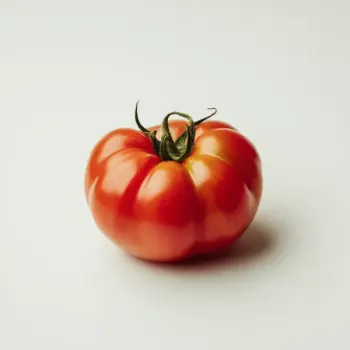Tomato paste and tomatoes are both used in cooking to add flavor to dishes, with tomato paste providing a concentrated taste and tomatoes offering a fresh and juicy profile.

Tomato paste is a thick concentrate made by cooking down tomatoes for several hours to remove the water content, and then straining and puréeing the remains. This process intensifies the tomato flavor, making it rich and robust.

Tomatoes are a versatile fruit that are commonly used as a vegetable in cooking. They come in a variety of shapes, sizes, and colors, each with a distinct taste profile ranging from acidic to sweet, adding freshness and moisture to dishes.
Tomato paste offers a deep, concentrated tomato flavor and a thick texture, making it ideal for adding richness to sauces and stews. Fresh tomatoes, on the other hand, provide a lighter taste, refreshing moisture, and can be used both raw and cooked in a variety of dishes.

Your ultimate Recipe Box, Meal Planner, and Cooking Class all in one
In Italian sauces such as marinara or Bolognese, tomato paste is used to add depth and body. A small amount can intensify the tomato flavor without thinning out the sauce. Fresh tomatoes are perfect for chunkier or fresher sauces like Pomodoro or a simple cherry tomato sauce. They offer a lighter, more vibrant taste and can be crushed, diced, or used whole.
Adding a spoonful of tomato paste to soups and stews can provide a rich backdrop of flavor. It works well in lentil soups, beef stews, and chili, where a concentrated tomato essence is desired. Fresh tomatoes are best suited for lighter, broth-based soups or stews where the fresh taste of tomato is desired. They can also add a pleasant texture to the dish.
Tomato paste can be a secret ingredient in casseroles and baked dishes, enriching the overall flavor without adding excess liquid. Fresh tomatoes can be layered into casseroles and bakes for a burst of moisture and flavor, such as in a traditional ratatouille or a tomato and cheese bake.
Tomato paste is higher in nutrients per volume due to its concentrated form, but both are good sources of vitamins and antioxidants.
| Nutrient | Tomatoes ( per 100g ) | Tomato Paste ( per 100g ) |
|---|---|---|
| Fat | 0.2g | 0.5g |
| Protein | 0.9g | 4.3g |
| Calories | 18 | 82 |
| Vitamin C | 13.7mg | 21.9mg |
| Carbohydrates | 3.9g | 18.9g |
| Dietary Fiber | 1.2g | 4.1g |
You can use fresh tomatoes instead of tomato paste, but you may need to adjust the recipe to reduce the liquid content elsewhere.
As a general rule, one tablespoon of tomato paste is equivalent to about one medium-sized tomato, once cooked down and concentrated.
Cooking tomato paste before adding it to your dish can help mellow its flavor and bring out its sweetness, making it a recommended step.
Tomato paste is more concentrated, so it offers more nutrients per volume, but fresh tomatoes have health benefits as well and are lower in calories.
Leftover tomato paste can be stored in the fridge for up to a week or frozen in an ice cube tray for longer storage.